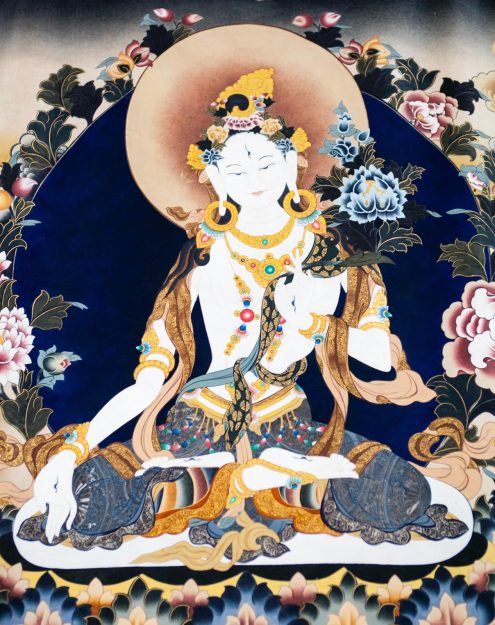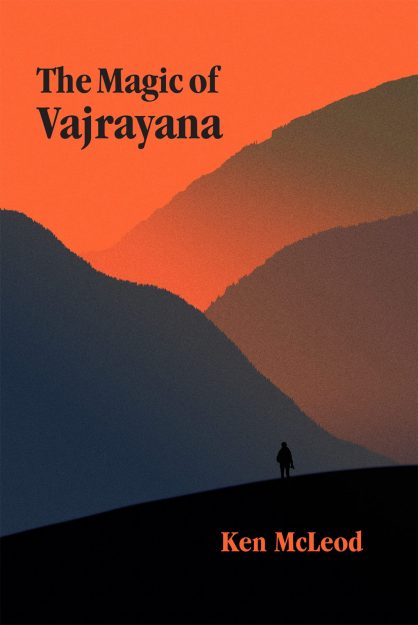It is not easy for Westerners to practice Tantric Buddhism, or even to come to a genuine understanding of why anyone would want to. We today are separated from the societies that produced the classic Vajrayana texts by vast distances of space, of time, and of fundamental cultural assumptions. The issue is not merely that the details of the rich and complex rituals can be perplexing. The fundamental nature of the practices themselves can be bafflingly obscure.
By Ken Mcleod,
Unfettered Mind Media, January 2023
262 pp., $29.95, hardcover
The Magic of Vajrayana speaks to these challenges in a new and powerful way. Ken McLeod vividly describes many of his own experiences from a life of Vajrayana practice, interweaving these with translations of practice-oriented texts from that tradition and with helpful comments and instructions on how to approach the practices they describe. This book is not for beginning practitioners and does not seem to be intended for the merely curious. Meant for committed spiritual seekers, the volume presents a searingly honest account of the suffering, challenges, and insights of a life spent engaging with a living mystical tradition.
If you call upon the protectors, be careful what you wish for!
McLeod’s reputation is largely based on his innovative and compelling translations from Tibetan, which often differ in striking ways from how Buddhist texts are more usually rendered into English. Rather than striving for a pedantic, philological form of accuracy or seeking to convey as much information as possible about how the texts fit into the cultural contexts that produced them, McLeod instead aims to evoke in the reader similar experiences and emotions to those that might have been felt by the original audience of the text. His translations strike at the heart, piercing our complacency with sharp words and opening doors to devotion, awe, compassion, and sheer clarity. Here is a taste of what he offers, verses from a traditional text depicting the meeting of Khyungpo Naljor with the mahasiddha Niguma:
Experience arises like magic.
If you practice like magic
You awaken like magic
Through the power of faith …Don’t think about your teacher or your practice.
Don’t think about what is real or not real.
Don’t think about anything at all.
Don’t control what you experience.
Just rest in how you are right now.
The largest portion of the book, covering three chapters, describes in detail a deity practice, called “Mastery of the Deathless,” for the goddess White Tara. McLeod’s exposition of this practice is detailed, illuminating, and inspiring; he brings the reader face-to-face with the majesty and wonder of the imagery involved. Many aspects of his discussion relate to fundamental issues about how to approach Tibetan Buddhist practice more generally. McLeod vigorously rejects the use of terms such as “imagination” and “visualization” to explain creation-phase practice. Such terms, he warns, encourage students to think their way through the practice. They carry the implication that it is necessary to control what you experience during the ritual. And then, “Twenty years later, if you are still doing deity practice, you wonder why nothing has changed. Nothing changed because you never left the conceptual mind. . . . To engage deity practice effectively, stay in the clear empty knowing that is just there when you recite the spell. Rest right there and let the practice unfold.”
As often in his earlier teachings, McLeod emphasizes the importance of balance in a life of spiritual practice. Pushing too hard, going to excess, can lead to serious adverse consequences. McLeod notes that movement practices, such as t’ai chi and qigong, were helpful to him after his own practice led to severe and long-lasting health issues. He also presents instructions for a mountain–offering ritual as a means to maintain or restore balance.
The volume also includes a complete description, with the necessary mantras, of a practice invoking a six-armed form of the protector deity Mahakala. Here the reader encounters the bizarre and unsettling side of Tantric practice. The explanations provided are enormously helpful in making sense of how such texts can fit into a way of life shaped by a commitment to spiritual awakening.
McLeod’s presentation of the protector ritual crackles with intensity, producing a disturbing effect that, for some, may include an edge of actual terror. Some would question the wisdom of the decision to make such a text available to the reading public. However, for anyone who takes such practices seriously enough to want to engage in them, McLeod’s own account of their effects in his life should be a sufficient warning: if you call upon the protectors, be careful what you wish for!
His translations strike at the heart, piercing our complacency with sharp words and opening doors to devotion.
The last chapter of the book, “Living Practice,” distills insights from McLeod’s spiritual journey into clear, direct words of advice. This chapter does much to clarify how McLeod understands how Vajrayana methods relate to the shared aims of Buddhist traditions generally. His advice ranges widely across a broad variety of practices and shows how different methods can enhance and support one another.
Those practitioners who are struggling to make sense of what Vajrayana practice instructions actually mean, and to fit them into the context of Buddhist values and aspirations, may well be grateful for McLeod’s book and for its deeply practical, experiential approach. Other readers will appreciate that the text preserves rare and precious teachings from the Shangpa lineage of the Kagyu tradition, teachings likely to be unfamiliar even to those who are deeply versed in other forms of the Tibetan tradition. And some at least of those who engage with this book may find that new possibilities have opened, and their understanding of how to practice has shifted, through the workings of the ancient Vajrayana teachings manifesting in a fresh, vivid, and unrelenting form. Again and again, McLeod’s words lead us out of concepts, frameworks, and theories and plunge us directly into the majesty of ritual, the darkness of suffering, and the mystery of life.
Listen to an interview with Ken McLeod here.

Becoming White Tara
You are White Tara. You sit in a crystal palace on a lotus and moon throne. Delicate elegant silks drape your white body. Gold jewelry set with diamonds, sapphires, emeralds, rubies, and topaz highlights your every feature. You have seven eyes. The eye in your forehead looks into the essence of being. The two other eyes that grace your countenance take in the infinities upon infinities of beings that arise, abide, and vanish in the countless world systems that themselves come and go over eons in the vastness of infinite space. Four more eyes, on the palms of your hands and the soles of your feet, take in the pain and confusion of every being in every world. With a combination of understanding and compassion you see how each and every one of them struggles in their life. Your ability and willingness to help them are expressed in your right hand, extended in a gesture of unending giving. Your left holds at your heart the stem of a lotus flower that blooms by your head, a reflection of the utter purity that is present even in the swamp of samsara. You sit relaxed and at ease, the consummate serenity in your bearing devoid of any trace of self-consciousness or self-importance. . . .
Touch now the purpose of your life, the sole reason why you are here: to help beings know in themselves a peace that is inexpressible in words, a peace that transcends understanding, a peace that immediately frees all who touch it from the confusion and reactivity of samsara.
♦
From The Magic of Vajrayana © Ken McLeod. Reprinted with permission.
